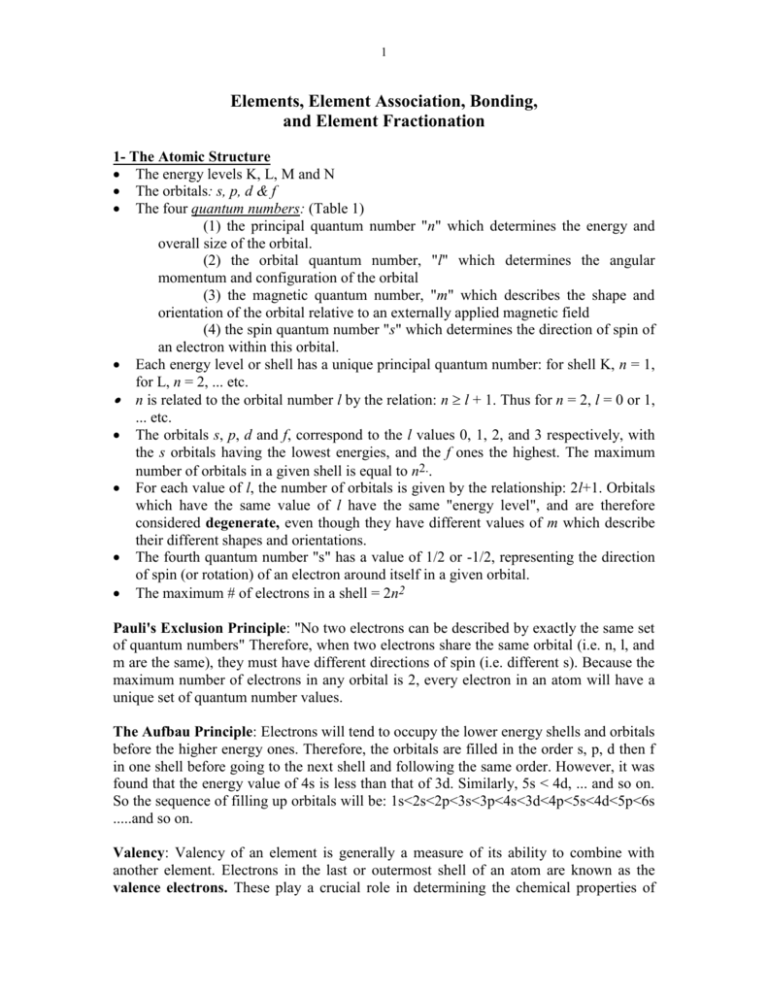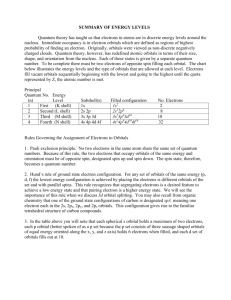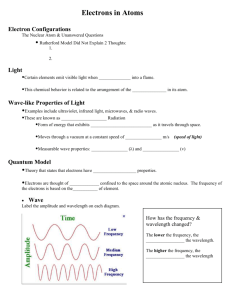Element association & distribution
advertisement

1 Elements, Element Association, Bonding, and Element Fractionation 1- The Atomic Structure The energy levels K, L, M and N The orbitals: s, p, d & f The four quantum numbers: (Table 1) (1) the principal quantum number "n" which determines the energy and overall size of the orbital. (2) the orbital quantum number, "l" which determines the angular momentum and configuration of the orbital (3) the magnetic quantum number, "m" which describes the shape and orientation of the orbital relative to an externally applied magnetic field (4) the spin quantum number "s" which determines the direction of spin of an electron within this orbital. Each energy level or shell has a unique principal quantum number: for shell K, n = 1, for L, n = 2, ... etc. n is related to the orbital number l by the relation: n l + 1. Thus for n = 2, l = 0 or 1, ... etc. The orbitals s, p, d and f, correspond to the l values 0, 1, 2, and 3 respectively, with the s orbitals having the lowest energies, and the f ones the highest. The maximum number of orbitals in a given shell is equal to n2.. For each value of l, the number of orbitals is given by the relationship: 2l+1. Orbitals which have the same value of l have the same "energy level", and are therefore considered degenerate, even though they have different values of m which describe their different shapes and orientations. The fourth quantum number "s" has a value of 1/2 or -1/2, representing the direction of spin (or rotation) of an electron around itself in a given orbital. The maximum # of electrons in a shell = 2n2 Pauli's Exclusion Principle: "No two electrons can be described by exactly the same set of quantum numbers" Therefore, when two electrons share the same orbital (i.e. n, l, and m are the same), they must have different directions of spin (i.e. different s). Because the maximum number of electrons in any orbital is 2, every electron in an atom will have a unique set of quantum number values. The Aufbau Principle: Electrons will tend to occupy the lower energy shells and orbitals before the higher energy ones. Therefore, the orbitals are filled in the order s, p, d then f in one shell before going to the next shell and following the same order. However, it was found that the energy value of 4s is less than that of 3d. Similarly, 5s < 4d, ... and so on. So the sequence of filling up orbitals will be: 1s<2s<2p<3s<3p<4s<3d<4p<5s<4d<5p<6s .....and so on. Valency: Valency of an element is generally a measure of its ability to combine with another element. Electrons in the last or outermost shell of an atom are known as the valence electrons. These play a crucial role in determining the chemical properties of 2 most elements. Elements in which all orbitals are completely filled with electrons are the most inert or stable from a chemical point of view (e.g. the inert gases He, Ne, Ar, ... etc.). Atoms of all other elements will be chemically reactive, and will attempt to reach the stable configuration of the inert gas with the atomic number closest to its own. They do so either by transfer of electrons to the orbitals of another atom, resulting in ionic valency, or by modification of shapes of orbitals and sharing electrons between two atoms (covalency). The type of valency is determined by the ionization potentials, electron affinities and electronegativities of the atoms. Ionization Potential: Is the energy (in eV) required to cause any atom to lose an electron and thus become a cation. Ionization potentials for all atoms are always positive. Electron Affinity: is the energy required to convert an atom to an anion. Electron affinities may be positive or negative. Electronegativity, as defined by Nobel prize winner Linus Pauling, is a measure of the ability of an atom in a molecule to attract electrons to itself. Pauling devised an empirical scale for the electronegativities of elements, where Cs, the most electropositive element, was assigned a value of 0.7, whereas F, the most electronegative element, was given a value of 4. Table 2 lists the electronegativity values of Pauling for some common elements of geologic interest. A similar scale can be derived based on the relationship: Electronegativity = 1/2 (Ionization potential + Electron affinity). The difference between the values of electronegativities of two elements will determine the type of bond that these two elements will form in a compound. 2- The Periodic Table: (Fig. 1) Periods and Groups Period # = Principal quantum # (n), or # of energy levels that are being filled with electrons. Group #: # of electrons in the outermost shell (valence electrons) Metallic Character: decreases from groups I to VIII, but increases going down each group (i.e. from one period to the next), although the latter is less pronounced! Ionic Radii: The largest ions within a period occur at the beginning and end of that period. On the other hand, ionic radii increase systematically down each group. For elements with more than one oxidation state, the higher the oxidation state, the smaller the ion (Fe3+ is smaller than Fe2+). Note that ionic radii vary as a function of coordination #; the larger the C.N., the larger the radius (even for the same element; Fig. 3). 3- Types of Elements: a) Alkali metals b) Alkaline Earth elements c) Halogens: all gases; strongly electronegative. d) Inert (noble) gases: unreactive e) Transition elements: 3 incompletely filled d orbitals All are metals Many oxidation states; d- electrons often serving as valence electrons. properties not easy to predict from the periodic table. f) Platinum Group elements: A subgroup of transition elements that includes the elements: Ru, Rh, Pd, Os, Ir, and Pt. Can occur in the native state, or with many valencies (+2, +3, +4, +6). Are mostly associated with Fe in nature. g) Lanthanides and Actinides: All have 3 valence electrons. Incompletely filled f orbitals; with increasing Z, filling of the f located two orbitals below the ultimate orbital or shell. Lanthanide contraction: progressive decrease of ionic radius with increasing atomic number. Outer electronic structure for these elements is so similar that they have almost identical chemical properties. Eu & Yb: Oxidation of state of +2 is actually preferred (unlike the other REE), but the +3 oxidation state is also possible and common. 4- Goldschmidt's classification of elements: (Fig. 2; Table 3) A qualitative classification based on element associations, and assumes that the earth was initially molten. In a molten earth, elements would be distributed between four phases: Fe rich liquid, sulphide liquid, slag (silicate – rich), and a gas phase. Siderophile elements: dominantly noble metals with low electrode potentials that occur in the middle of the periodic table (mostly transition elements). Chalcophile elements: intermediate electrode potentials Lithophile elements: high electrode potentials; occur at both ends of the periodic table. Atmophile elements: H, N, and the inert gases. Overlaps between the different groups, with some elements belonging to more than one group different physicochemical conditions of formation of different rock types govern this behavior to some extent. 5- Bonding The interaction between two atoms to form a molecule or a compound is known as bonding. This process attempts to attain the lowest possible energy for the whole system. Stated simply, this is accomplished when an atom loses, gains, or shares electrons with one or more other atoms in its attempt to reach a configuration similar to that of its nearest noble gas, and minimize the energy of the system. There are several types of bonds, the most important of which (from a geological point of view) are: Ionic, Covalent, Metallic, van der Waals, hydrogen, and coordination bonding. 4 The type of bond is a function of: (i) Electronic configuration of the atoms being bonded, especially that of the valence electrons (ii) Electronegativity of the combining elements 6- Crystal Structures Radius of each ion/ atom controls the overall geometric configuration of the structure and its coordination number (for the cation, the coordination number is the number of nearest anions surrounding it). Radius ratio determines the coordination number and the configuration of each structure (Fig. 4). The charge on the individual ion also plays a role in controlling the overall structure (as it affects the coordination number; Fig. 3). In the case of covalent compounds, the structure is determined primarily by the type of hybridization (Fig. 5), and to a lesser extent on the radius ratio of the combining elements/ ions. Covalent radius is different from the ionic radius of the same element. It is equal to half the distance between the two bonded atoms. Most minerals have more than one type of bonding, and most bonds are neither purely ionic nor purely covalent, but have a mixed character. Note that the ionic or covalent character of a bond will be determined by the electronegativities of the two elements involved. A large difference in the electronegativity of the two elements will result in a bond that is predominantly ionic. On the other hand, an electronegativity difference of zero produces a purely covalent bond, unless the atoms involved are all fairly electropositive and have a few electrons and many empty orbitals, in which case bonding will be metallic. 7- Isomorphism: Is the substitution of one cation (or anion) for another in a mineral or compound. For such substitution to occur, the substituting ions have to be of similar sizes, and the structure of the mineral after substitution has to be electrically neutral (see Goldschmidt's rules). Complete isomorphism, as in the case of olivine, occurs when the substituting ions are of similar sizes and charges. If that is the case, the two end-members may be considered completely miscible in the solid state, a phenomenon also known as solid solution. When the two ions differ in size, the miscibility between the two end-members may not be complete (except perhaps at very high temperatures) and we are left with two minerals each rich in one end-member, instead of a single mineral. Because the charge (Z) and radius of ions or elements are so important, it is useful to define the ionic potential as Z/r. 8- Goldschmidt's Rules of Ionic substitution: Are important for predicting which elements can enter or substitute for other elements in mineral structures, and therefore for understanding the distribution and association of elements. (1) Extensive substitution if differences in r+ is 15% 5 (2) Electrical neutrality and coupled substitutions: if difference in Z is > 1, substitution is slight or difficult. (3) Higher Z/r is favoured. (4) Two substituting ions should also have similar electronegativities. 9- Substitution of trace elements in crystal structures: Three modes of substitution are known: o Capture: Z/r of trace element > Z/r of substituted major element o Camouflage: similar Z/r o Admission: Z/r of trace element < Z/r of major one. Will not occur if difference in radius > 15%! 10- Distribution Coefficients (Fractionation factors): The distribution of elements among different coexisting phases (e.g. two minerals, a mineral and a fluid; a mineral and a melt; … etc.) will depend on a number of factors, most important of which are the nature of this element (size, charge, chemical affinity, … etc.), T, P, composition of the phases, oxygen fugacity, … etc. In all cases, investigation of this phenomenon begins with calculating a distribution coefficient (kd) also know as a fractionation factor defined as Kd = CA/CB where CA and CB are the concentrations of the element of interest in the phases A and B, respectively. Table 4 lists the Kd values for mineral - melt pairs for some selected trace elements, which has a profound effect on the distribution of these elements in igneous rocks. The same concept of Kd (this time between sedimentary minerals and water reservoirs) can be used to help explain the concentrations of trace elements in sedimentary rocks (Table 5). A full quantitative approach to this problem would involve studying factors controlling Kd from an equilibrium versus a kinetic point of view, the subjects of our next chapters.





